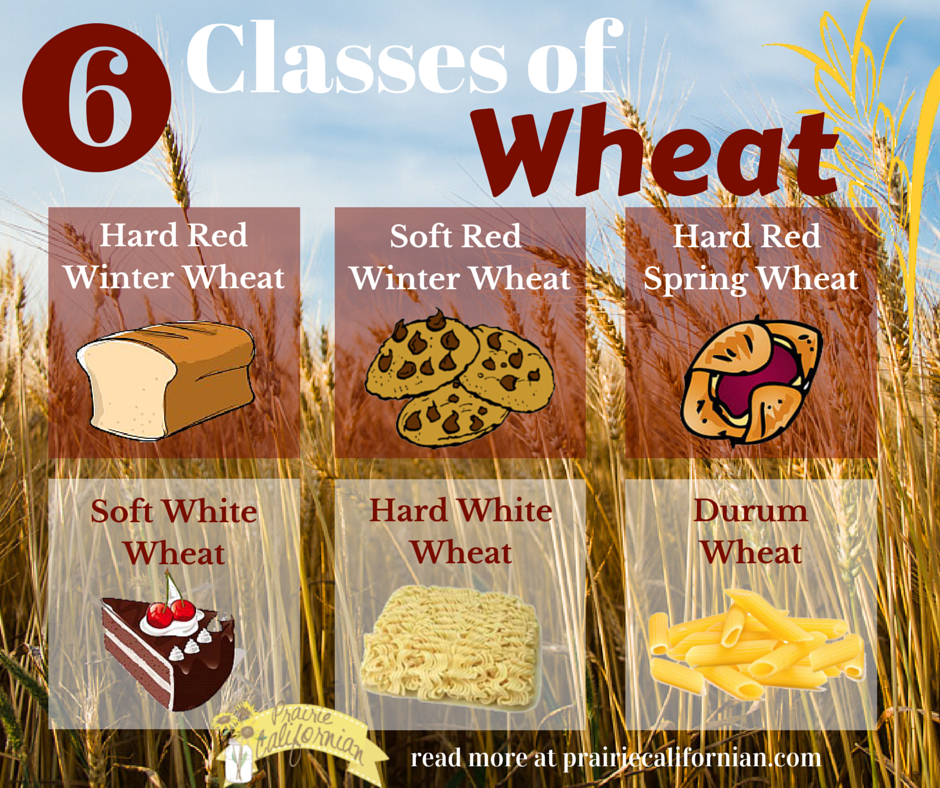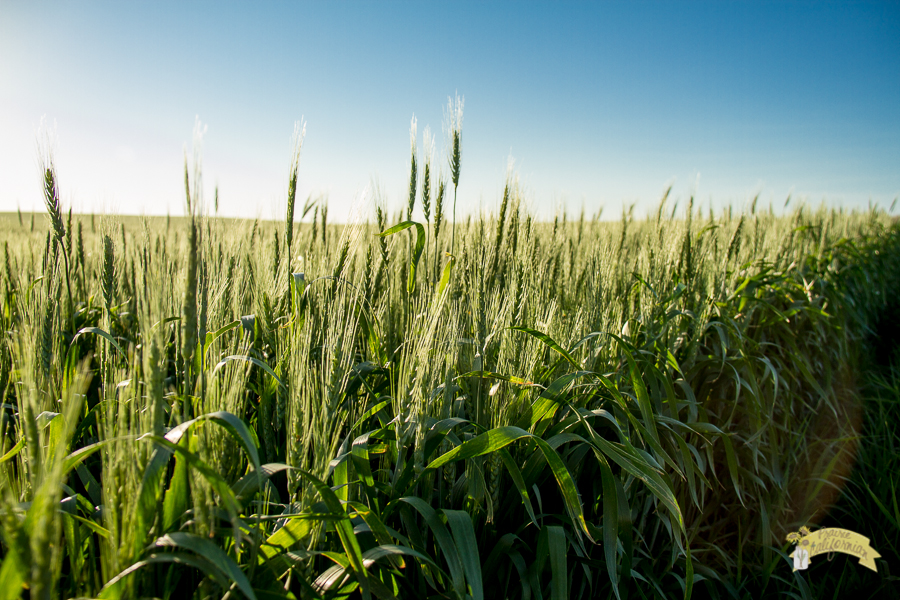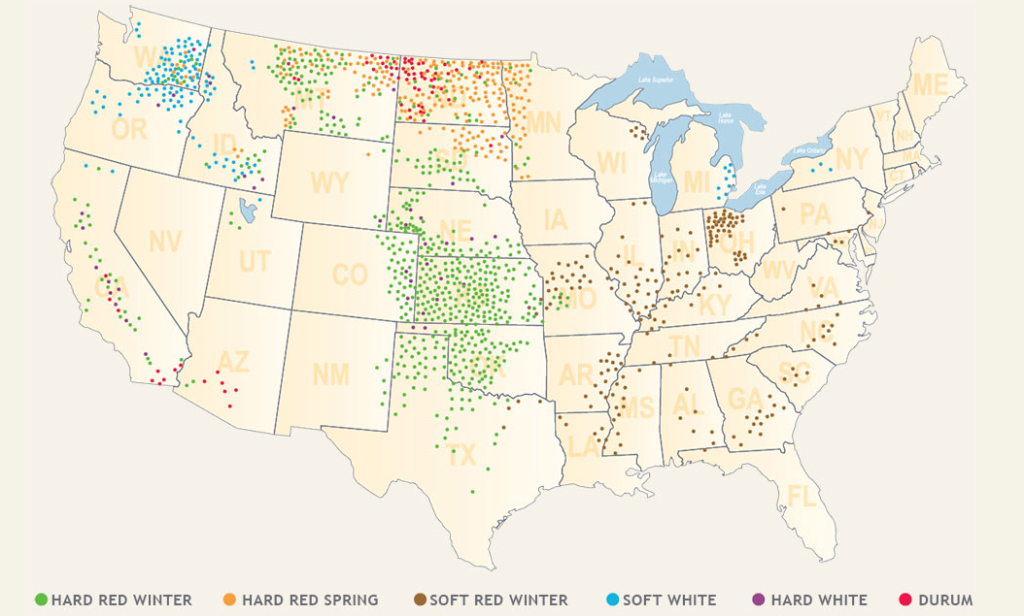
Wheat is one of the four crops we grow on our farm. We grow wheat on our farm because it works well in our rotation. We grow hard red spring wheat which is a short season cool grass that does extremely well in our area if met with favorable conditions. But even outside of our farm, wheat an extremely important crop to North Dakota as well as throughout the United States.
The next couple weeks, I want to discuss some of the myths behind wheat production and talk about some of the facts when it comes to wheat. Hopefully through these posts, you will realize how vital and important wheat is to our nation’s economy as well as our local economies but more so, I hope you will realize the importance of having choice when it comes to the wheat grown across the nation. Even if you choose not to indulge in wheat products, it is certainly not something to be afraid of.
You may remember back when I shared the Truth About Toxic Wheat, I talked about how important it is to remember that in Agriculture, one size does not fit all. The production methods we use here on wheat in North Dakota aren’t necessarily the production methods used throughout the rest of the nation and we clearly saw that through the toxic wheat article going viral. But why is that?
Well, mainly because of our climate, soils, and other variables but it also has to a lot with the class of wheat we are growing. The problem lies when we try and make blanket statements about all wheat production. For each different class of wheat, there are different production methods and much of that depends on the wheat growing seasons too. Let’s talk first about the two growing seasons.
Wheat Growing Seasons
Wheat in the United States has two distinct growing seasons. Winter wheat is sown in the fall and harvested in the spring or summer; spring wheat is planted in the spring and harvested in late summer or early fall.
Winter Wheat
Winter wheat is planted in the fall, goes into dormancy during the winter, and is harvested for grain the following spring. Winter wheat accounts for 70 to 80 percent of U.S. production and is grown all the way from Montana down to Texas with a heavy concentration in the Great Plains area. Some benefits of planting winter wheat include:
- Erosion control: winter wheat can serve as an overwinter cover crop for erosion control in parts of the U.S. Winter wheat is a plentiful source of straw and stubble to keep topsoil from washing away
- Takes advantage of fall moisture: Winter wheat is often planted to take advantage of fall moisture which reduces problems of limited spring and early summer moisture. Since winter wheat matures earlier in the year than spring wheat, it is less subject to extreme summer heat in southern climates.
- Weed suppressor: as a fall planted crop, wheat competes well with most weeds once it is established. It’s rapid growth in the spring (when most weeds begin to grow again) helps choke weeds as they compete for light and surface nutrients.
- Is an excellent double crop: Much of the United States does what is called double cropping. When the wheat is harvested in the spring, another crop is then planted and harvested in the fall before another crop of winter wheat is planted in the fall.
Spring Wheat
Spring wheat is planted in the late spring and harvested late in the summer (for us typically around August). Annual rainfall in the northern Great Plains (like North Dakota, parts of Minnesota, and Montana) is relatively limited but well distributed during the summer, thus favoring spring wheat production. Some benefits of planting spring wheat include:
- No vernalization requirement: Spring wheats have no vernalization requirement which basically means they don’t require a cold spell to trigger flowering. In our area like North Dakota, there are risks involved in planting winter wheats in late winter or early spring conditions as the wheat can be subject to a winter kill.
- Cool summers are beneficial: One of the reasons spring wheat grows best in the northern areas of the country is because our summers are mild and not too hot for young, tender plants.
- No time to plant winter wheat: For many growing roots, vegetables, or maize crops, we are bound by later fall harvest which does not allow us to plant winter wheat at its’ optimum time of September – October. The adaptation of spring wheat has allowed us to get the best out of both crops.
- High market value: In some years, high protein levels in spring wheat are often rewarded by substantial price premiums.
Here in North Dakota we may only represent a small portion of total U.S. wheat production, but we account for more than half of all U.S. spring wheat produced. I know, it is confusing. This map from the U.S. Wheat Associates does a great job of illustrating this:
See the orange dots above? They are mostly concentrated to North and South Dakota as well as parts of Minnesota and Montana. The rest of the nation is mainly growing winter wheat. But even in those two growing seasons of winter wheat and spring wheat, there are different classes as shown by all the different colored dots above. So what are those six classes and what are they used for?
Six Different Classes of Wheat
Before researching this, I really had no idea that so many different classes of wheat existed. I mean, I thought flour is flour right? Wrong. Different wheats are used for different things. Some may be used for bagels while others are used for things like pasta. Wheat classes are determined not only by the time of year they are planted and harvested, but also by their hardness, color and the shape of their kernels. Let’s start with the most widely produced.
Hard Red Winter Wheat
Hard red winter wheat (HRW) is an extremely versatile wheat, with excellent milling and baking characteristics for pan bread. It is the class of wheat used mostly for bread and all-purpose flour. This wheat has medium to high protein content, about 10-14% and a mellow gluten content. Hard red winter wheat accounts for more than 40% of the U.S. wheat crop and half of U.S. wheat exports. It is also a choice wheat for Asian-style noodles, hard rolls, flat breads, tortillas, general purpose flour and cereal.
Soft Red Winter Wheat
Soft red winter wheat (SRW) is versatile wheat with excellent milling and baking characteristics for cookies, crackers, pretzels, pastries and flat breads. Soft red winter wheat is a high-yielding wheat with low protein, about 8.5 – 10.5%, and weak gluten content. It is traded at the Chicago Board of Trade and typically grown east of the Mississippi.
Hard Red Spring Wheat
Hard red spring wheat (HRS) is known as the “aristocrat of wheat” when it comes to designer wheat foods. This wheat has the highest protein content, about 12.0 to 15.0 percent, strong gluten, and high water absorption. It is found in speciality items like hearth breads, rolls, croissants, bagels and pizza crust. Hard red spring wheat is often blended with other flours to increase gluten strength. It accounts for nearly 20% of U.S. wheat exports and is traded through the Minneapolis Grain Exchange (MGE). It is the only cash grain market in the world and is the only exchange that trades hard red spring wheat futures contracts.
Soft White Wheat
Soft white wheat (SW) is used much the same way as soft red wheat for pastries rather than breads. It has a low protein, about 8.5 to 10.5 percent, but produces high yields. It also has low water absorption and provides excellent milling results. It is used in products like exquisite cakes, pastries and Asian-style noodles. Soft white is also ideally suited to Middle Eastern flat breads.
Hard White Wheat
Hard white wheat (HW) is the newest class of wheat to be grown in the United States. Hard white wheat is closely related to red wheats in its’ milling and baking qualities, however, it has a milder, sweeter flavor. Hard white wheat has a medium to high protein content, about 10 to 14 percent. It is used in instant or ramen noodles, whole wheat flours, tortillas, and other yeast breads. Hard white wheat is used mostly in domestic markets and is exported in limited amounts.
Durum Wheat
Durum wheat, from the Latin word for hard, is the hardest of all wheat classes with amber-colored kernels larger than those of other wheat classes. Durum has a high protein content about 12.0 to 15.0 percent and is used most widely in pasta products and some Mediterranean breads. When the durum is milled, the endosperm is ground into a granular product called semolina. Durum accounts for less than 5% of all U.S. wheat exports with 68% grown annually in North Dakota.
Did you know there were six different classes of wheat? Have you used some of these different classes in your own kitchen?
Resources
-
Beuerlein, J. (2001) Classes and Uses of Wheat
-
California Wheat Commission. (2014) California and U.S. Wheat Classes
-
Montana Wheat & Barley Committee. (2012) Six Classes of Wheat
-
North Dakota Wheat Commission. (2014) Facts About Hard Red Spring Wheat
-
U.S. Wheat Associates. (2013) Wheat Classes





In Eastern Washington we grow soft white winter wheat. We plant in September and harvest in late July, early August. We do not double crop but instead lay the field fallow for a year. Our area receives an average of ten inches a year and the acreage is divided between fallow and seeded. The fallow field.is fertilized and kept weed free until.we seed it the next September. I love how there are so many different ways to farm! Thanks for sharing this information with us.
Very interesting. Can you do an article on the “ancient wheats” – spelt and the others?
Durum grows well in Arizona – and there is a pasta maker near Phoenix buying most of the output.
It doesn’t show on your map, but the Navajo Nation has their own flour mill, grows hard red winter wheat and some durum. Their flour is sold mainly in the Four Corners states.
My local flour choices are pretty wild – Navajo Pride, High Altitude Hungarian, some Montana grower/miller … and then that DoughBoy company. And Blue Bird.